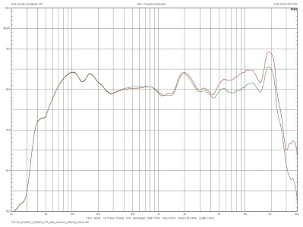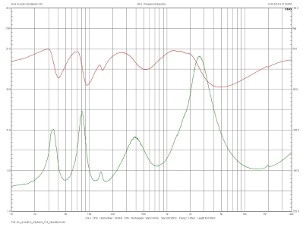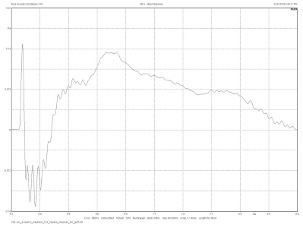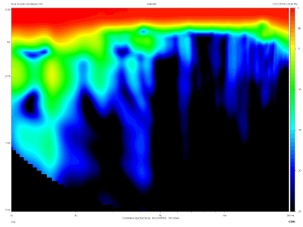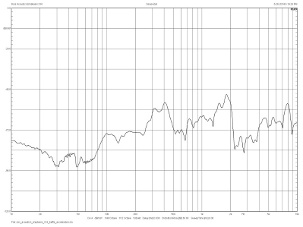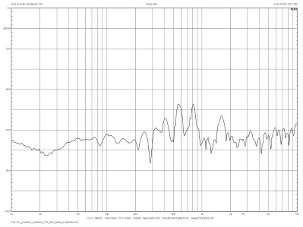about Audio, High Fidelity
& Home Entertainment technologies
pid: 607-2025/10/01 (v1.2)
Privacy Policy

Quasi-anechoic response (above 500Hz, on axis) is characterized by two frequency regions wherein a relative increase in sensitivity occurs. These are identified as the intervals between 1.6kHz and 2.6kHz and between 4.8kHz and 14.8kHz. Based on the average calculated sensitivity, it is interesting to observe that this increase is only slightly over 3dB in both cases (+3.3dB and +4.3dB respectively). Therefore, Emphasis 314 remains near the typical interval limit of ± 3dB over its mid and high frequency bandwidth, a performance that could be considered more than just fair, given its price. Above 15kHz a quite strong resonance makes its appearance, probably from the tweeter dome, its center located close to 20kHz. The effect of the protective grille, shown in the same diagram, is not negligible as it causes a significant (albeit small in amplitude) drop of sensitivity around 3.5kHz.
Summed response of the loudspeaker, obtained by splicing near filed and quasi-anechoic measurements (and applying 0.33oct. smoothing) discloses a generally balanced sound character. Mean sensitivity was estimated to 87.3dBSPL/2.83Vrms /1m (somewhat lower than the figure quoted by the manufacturer which is 90dB, but one should remember that the method of calculation of the average sensitivity systematically leads to lower values). Based on the estimated sensitivity, loudspeaker deviations remain within the interval [+ 3.8dB, -2.3dB]. The region between 70Hz-220Hz is characterized by a mild gain of about 3dB, with the additional observation that the measurement was made in the near field, not including any enhancement due to the location of the drivers near the floor. Therefore, the relevant diagram does not include any HSBR effect. Based on the average sensitivity, the speaker cutoff points are 53Hz (-6dB) in the lows and 25.5kHz (-6dB) towards the highs. Corresponding values for -3dB attenuation are 60Hz and 24kHz.
On-axis and average response comparison leads to the conclusion that the loudspeaker radiates evenly in space and shows no abrupt changes in relation to the listening position at least for a solid angle confined by ±15°.
Quasi-anechoic frequency response (dBSPL/2.83V/m) above 500Hz, measurement at 2m distance, with and without the protective grill (red and green curve, respectively).
Summed frequency response (dBSPL/2.83V/m), far field/near field splicing, with 0.33oct smoothing. On-axis (red curve) and averaged on/off axis response (green curve).
Behavior of Emphasis 314 as an amplifier load can be regarded as good. Impedance magnitude does not fall below 4 ohms (4.1 at 10Hz) and at the bass reflex resonance frequency (50Hz) is about 4.8 Ohms, a performance that allows us to consider the loudspeaker as a typical 6-Ohm load, as Rois Acoustics states in their specs. Total magnitude variation is about 15 Ohms, a quite low value that leaves some room for an amplifier with moderate or low damping factor to drive the loudspeaker without introducing any substantial deviation in frequency response. Impedance phase variation is quite typical in range and is mainly inductive in character in the range of lows and mid/lower high frequencies, a behavior implying that the driving amplifier will not be needlessly overheated.
Step response of the loudspeaker (on axis at 2 meters distance) is typically good, with a resonance in the range of 17kHz making quite a strong appearance in the transition area between the tweeter at the midrange drivers. Woofer decay appears to be quite smooth.
Cumulative spectral decay analysis of the Emphasis 314 reveals a series of resonances, of which the one centered around 4kHz seems to be the slowest in decay (>2.3mS to fall below -25dBr). Above this frequency, the loudspeaker appears to be quite fast, showing some notable resonances at 6.5kHz, 12.2kHz and 17.2kHz with decay times of 1.8, 1.6 and 1.4mS respectively.
Polar response is very smooth. It is striking that the relevant curves remain within the boundary of ±3dB for angles greater than ±30°. Therefore, it is not necessary to toe-in the loudspeakers and, also, the reverberation field created in a room with a decent acoustic behavior will be smooth and will positively contribute to the overall feel.
Cumulative Spectral Decay graph, on-axis, quasi-anechoic measurement.
Polar response diagram in the horizontal plane. Frequencies : 1kHz (red curve), 2kHz (green curve), 4kHz (gray curve), 8kHz (orange curve) and 16kHz (purple curve).
Cabinet coloration appears to be quite low leading to the conclusion that Rois Acoustics made some good choices both in materials and bracing. The thickness of the front baffle is probably responsible for the generally low in both level and sharpness resonances, while the side panels appear to contribute some more clearly defined peaks. Of these, the strongest are at 560Hz and 820Hz. In any case, the associated levels are very low, below -50dBm/S².
Front baffle acceleration analysis in the frequency domain. Measurement with the accelerometer positioned midway between midrange and woofer drivers
Side panel acceleration analysis in the frequency domain. Measurement with the accelerometer positioned in the center of the side panel.


